Hideo Sawada
Biodegradable Plastics Society
Convener, ISO/TC61/SC5/WG22
Abstract: In 1992 the 41st ISO/TC61 meeting was held in Beijing, China. At the meeting, the Japanese delegation planned to create a new working group (WG) on biodegradation.Consequently, WG 22 of the sub-committee 5 (SC5) was created at the 42nd ISO/TC61 meeting in 1993. Rapid advances have been made in this area since WG22 was created in 1993.
So far, three aerobic test methods (ISO 14851, 14852, 14855), two disintegration test methods under composting conditions (ISO 16929, 20200) and one aerobic soil burial test method (ISO 17556) have been published. At present, we have six published ISO standards in total. In addition, two anaerobic test methods (ISO 14853, 15985) will be published soon.
Recently, a vote on the new work item ISO14855-Part 2, which was proposed by Japan, was approved. In this connection, international round robin testing on ISO 14855-Part 2 has been carried out in cooperation with seven countries (China, Japan, USA, Sweden, Italy, India and Belgium).
1. ISO (International Organization for Standardization)(1)
ISO (International Organization for Standardization) is the largest developer of standards in the world. ISO is a network of the national standards institutes of about 150 countries, on the basis of one member per country, with a Central Secretariat in Geneva, Switzerland, that coordinates the system. Membership of ISO is open to national standards institutes or similar organizations most representative of standardization in their country (one member in each country).
ISO has built a strategic partnership with the WTO (World Trade Organization) with the common goal of promoting a free and fair global trading system. The WTO's Agreement on Technical Barriers to Trade (TBT) includes the Code of Good Practice for the Preparation, Adoption and Application of Standards.
2. ISO Project approach (1)
The technical work of ISO is highly decentralized, carried out in a hierarchy of some 2 940 technical committees(TC), subcommittees (SC) and working groups (WG). In these committees, qualified representatives of industry, research institutes, government authorities, consumer bodies, and international organizations from all over the world come together as equal partners in the resolution of global standardization problems.Some 30 000 experts participate in meetings each year.
The major responsibility for administrating a standards committee is accepted by one of the national standards bodies that make up the ISO membership such as AFNOR (France), ANSI (USA), BSI (UK), SAC (China), DIN (Germany) and JISC (Japan).
3. Project stage and the related documents (2)
An International Standard is the result of an agreement between the member bodies of ISO. The national delegations of experts of WG meet to discuss and debate until they reach consensus on a draft agreement.
International Standards are developed by a six step process:
• Stage 1: Proposal stage (NWIP: New Work Item Proposal)
• Stage 2: Preparatory stage (WD: Working Draft)
• Stage 3: Committee stage (CD: Committee Draft)
• Stage 4: Enquiry stage (DIS: Draft International Standard)
• Stage 5: Approval stage (FDIS: Final Draft International Standard)
• Stage 6: Publication stage (IS: International Standard)
4. ISO Standards Developments of Biodegradability (3), (4), (5), (6)
In 1992, Japan expressed its intension to propose a new working group on biodegradability in Beijing ISO meeting. A new working group (WG22) of the subcommittee (SC5) on biodegradability was created by the ISO technical committee on plastics (TC61) in 1993. Rapid advances have been made in this area since then. The following aerobic biodegradation test methods were developed and published. The general features are summarized in Table 1 and 2
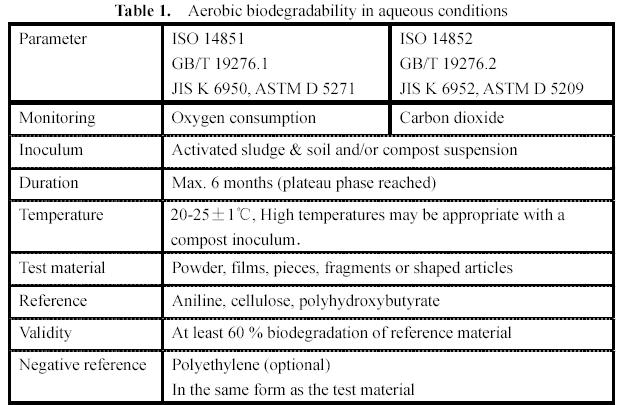 .
.
The systematic review process is used by ISO to ensure that the standards remain up-to-date and valid. A systematic review is required to be performed on each standard within a period of 5 years. Three aerobic test methods (ISO 14851, 14852 and 14855) were published in 1999. Therefore, these three standards are currently undergoing their systematic review.
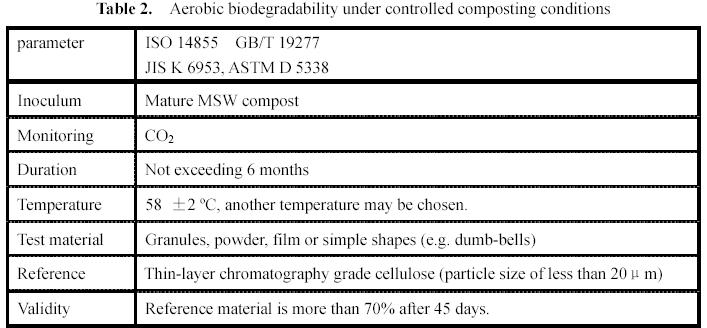
As indicated in Table 3, vermiculite and compost extract were used in place of mature compost as inoculum in the case of FDAmd1 to ISO 14855. Therefore, carbon balance was determined in this case. FDAmd 1 to ISO 14855 has been circulated to all national bodies for a 2 months voting.

As shown in Table 4, the amount of carbon dioxide can be periodically determined by increasing the weight gain in the adsorption column having absorbed carbon dioxide in the case of this new work item. By using sea sand it is possible to determine the weight gain in the adsorption column even in a very small scale (300ml).
The detailed comparison between NWIP (ISO 14855-2) and ISO 14855 is summarized in Table 5.
Two anaerobic test methods ISO 14853 (aqueous system) and 15986 (high solid content), which are shown in Table 6, will be published soon.
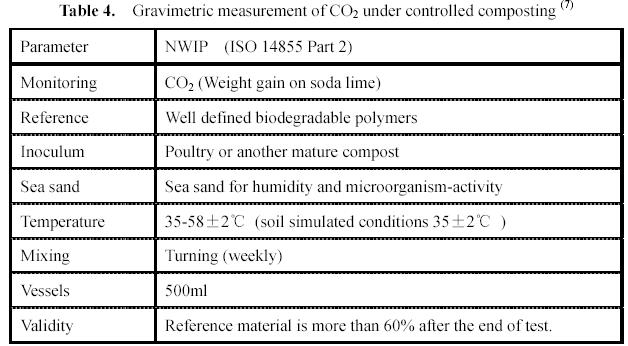

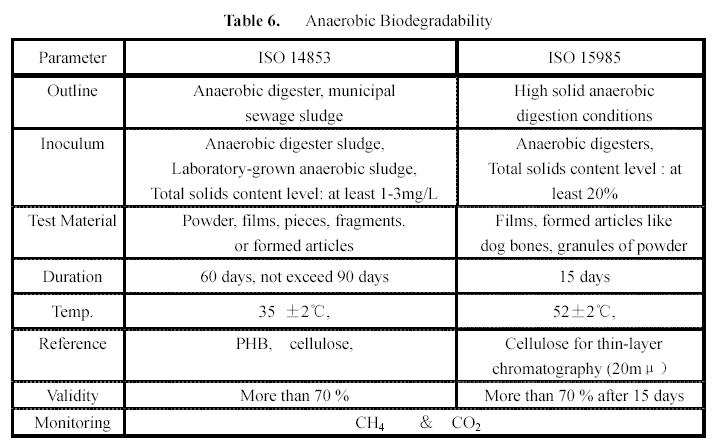
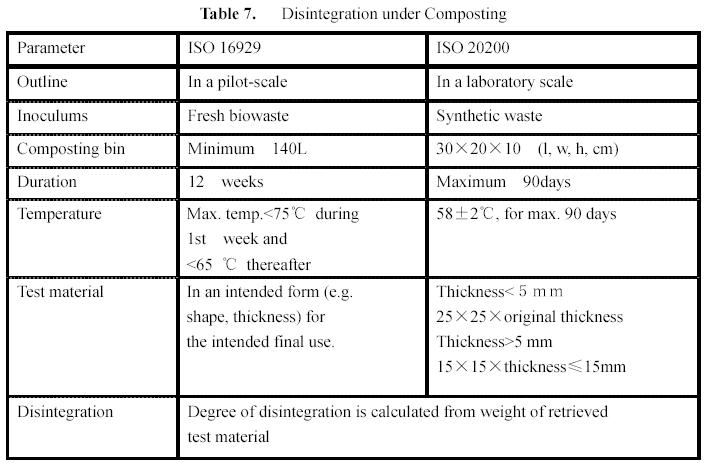

Two disintegration test methods (ISO 16929 and 20200) were published as indicated in Table 7. ISO 16929 is test method for determination of disintegration in a pilot scale. ISO 20200 is the test method for determination of disintegration in a laboratory scale.
ISO 17556 is the test method for determination of aerobic biodegradability in soil (Table 8).
Both CD 15986 (Test scheme) and CD 17088 (Specifications) were combined into a single CD 17088 (Test scheme and Specifications) in 2000. Since there is no available document on CD 17088, CD 17088 was cancelled under 2 years cancellation in 2003 as shown in Table 9.
5. Summary (3), (4), (6)
The present status of ISO standards of biodegradability of plastics is shown in Table 9. Six test methods were published. Two anaerobic test methods will be published soon. One new work item proposal (ISO 14855 Part 2) has been approved. In this connection, international round robin testing has been carried out in cooperation with seven countries (China, Japan, USA, Italy, Belgium, Sweden and India).
Since CD 17088 (Test scheme and specifications of composting) was cancelled under 2-years rule in October 2003, we should reinstate this work item by means of an NWIP. In order to avoid the 2-years cancellation and proceed to the advanced stage within 2 years, we need the nearly complete draft as an NWIP in future.
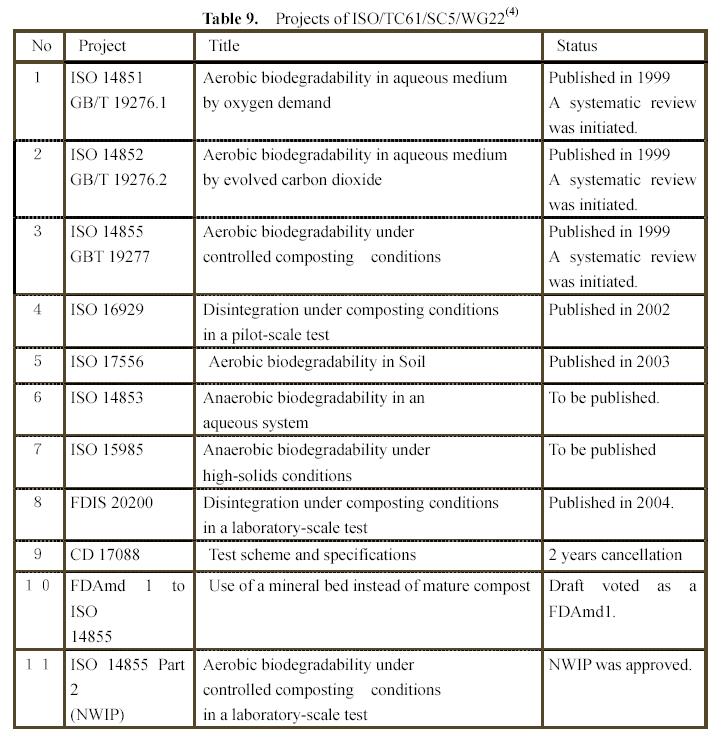
Acknowledgments
The author would like to thank Professor R. Narayan, Dr. U. Pagga, Mr. M. Pantke, Mr. B. De Wilde, Dr. F. Degli Innocenti, Dr. Y. Yakabe, Mr. K. Fukuda and Dr. S. Uematsu for their preparation of related ISO documents. In addition, I would like to thank Dr. S. Eldin (SC5 Chairman) and all members of WG22 including Mr. Weng Yunxuan for their support and cooperation.
References
1) ISO (URL) http://www.iso.ch/iso/en/aboutiso/introduction/index.html
2) ISO/IEC Directives, Part 1. Procedures for the technical work, ISO 4th Edition, 2001.
3) H. Sawada, Polymer Degradation and Stability 59 (1998) 365-370.
4) Hideo Sawada (URL) http://www.gulf.or.jp/~sawada
5) H. Sawada, in Y. Doi and K. Fukuda (ed.); Biodegradable Plastics and Polymers, 1994, p.298. Elsevier.
6) H. Sawada,, ICS–UNIDO International Workshop; Environmental degradable plastics,19-22 Sept.2000, Seoul (Korea), p.62.
7) A. Hoshino, M. Tsuji, M. Ito, M. Momochi, A. Mizutani, K. Takakuwa, S. Higo, H. Sawada and S. Uematsu, in E. Chiellini and R. Solaro (ed.), Biodegradable Plastics and Polymers, 2002, p.4, Kluwer.
ISO/TC61/SC5/WG22关于生物分解性的工作现状
摘要:1992年第41届ISO/TC61会议在中国北京召开。在这次会议中,日本代表团计划在生物降解领域建立一个新的工作组。因此,在1993年第42届ISO/TC61会议上成立了归属于第5分委员会(SC5)的22号工作组(WG22)。
到目前为止,已经颁布三个有氧测试方法(ISO 14851,14852,14855),两个堆肥条件下的分解测试方法(ISO 16929,20200)以及一个有氧土壤埋设测试方法(ISO 17556)。因此目前我们一共有了六个已颁布的ISO标准。另外,还有两个无氧测试方法(ISO 14853,15985)将在近期颁布。
最近,由日本提议的新工作项目ISO 14855-第二部分获得表决通过。在这一标准的联系下,七个国家(中国、日本、美国、瑞典、意大利、印度和比利时)联合开展了关于ISO 14855-第二部分的国际循环测试。
论文来源:1st International Conference on Technology and Application of Biodegradable Polymers and Plastics,October,2004